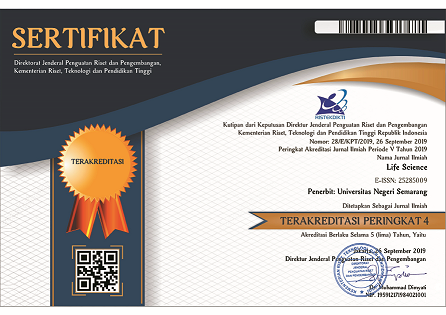Keanekaragaman Tumbuhan Berhabitus Pohon, Semak atau Perdu, serta Herba di Bantaran Sungai Kaligarang Kota Semarang
DOI:
https://doi.org/10.15294/unnesjlifesci.v13.i2.13979Keywords:
Plants, Diversity of Species, Kaligarang RiverAbstract
The Kaligarang River is one of the longest rivers in Semarang which is widely used for various purposes over time, this river has changed towards sedimentation and erosion. Therefore, the existence of vegetatiton is important as an ecosystem balancer. The purpose of this study is to study environmental parameters and analyze the diversity of plants found in the Kaligarang watershed. This type of research includes exploratory research with a line plot sampling method (5 quadrant plots) measuring 1x1 meters for herbs, 5x5 meters for shrubs/shrubs, and 10x10 meters for trees in May 2023-May 2024. Research locations at Tinjomoyo station, Tugu Soeharto, and behind PDAM Tirto Moedal. The results showed that the soil types found were sandy loam, clay, and dusty clay; soil pH between 5.51-6.23; C-organic content 0.32-0.94%; light intensity between 2950-7610 lux; ambient temperature 38°C-45°C, and air humidity 24%-43% which means that the quality of the environment is quite supportive of plant growth quite well. The results of the calculation of plant species diversity (H') with tree habitus was found at station 1 was 0,69 (low) and the highest at station 3 was 0.97 (low); the lowest shrub at station 2 was 0.45 (low) and the highest at station 3 was 1.19 (medium); and the lowest herbaceous at station 1 was 1.25 (medium) and the highest at station 2 was 2.92 (medium). The conclusion from these results is that environmental factors and plant diversity values at each station are different.Downloads
References
Bental, W. P., Siahaan, R., & Maabuat, P. V (2017). Keanekaragaman Vegetasi Riparian Sungai Polimaan, Minahasa Selatan-Sulawesi Utara. Bioslogos, 7(1), pp. 28–31. https://doi.org/10.35799/jbl.7.1.2017.16254
Etnovanese, N. C. K., Aprilia, T.M., Suwarno, D., & Setiyadi, B. (2019). Analisis Terhadap Kualitas Air Sungai Kaligarang sebagai Sumber Air Baku PDAM. G-Smart. Jurnal Teknik Sipil Unika Soegijapranata, 3(1), p. 47-62. https://doi.org/10.24167/gs.v3i1.1772
Handayani, P. (2018) ‘Keanekaragaman Vegetasi Riparian Sungai Tabir Desa Sungai Tabir Kecamatan Tabir Barat’, Jurnal Pendidikan Biologi dan Biosains, 1(1), pp. 21–27.
Hasthi, S., Budiati, L., & Setiadi, R. (2023). Identifikasi Kondisi Eksisting dan Dampak Sedimentasi Pada Sungai Kreo dan Kaligarang Kota Semarang. Saintifika, 24(2), p. 95-100. http://dx.doi.org/10.25037/saintifika.v24i2.133
Khairunnisa, C., Thamrin, E., & Prayogo, H. (2020). Keanekaragaman Jenis Vegetasi Mangrove di Desa Dusun Besar Kecamatan Pulau Maya Kabupaten Kayong Utara. Jurnal Hutan Lestari, 8(2), pp. 325–336. https://dx.doi.org/10.26418/jhl.v8i2.40074.
Komarawidjaja, W., & Garno, Y. S. (2016). Peran Rumput Vetiver (Chrysopogon zizanioides) dalam Fitoremediasi Pencemaran Perairan Sungai. Jurnal Teknologi Lingkungan, 17(1), p. 7. https://dx.doi.org/ 10.29122/jtl.v17i1.1459.
Lukas., Hastari, B., Ardianor., & Gumiri, S. (2021). Diversity of Riparian Plants of Black Water Ecosystem in the Sebangau River of Central Kalimantan Indonesian’. IOP Conference Series: Earth and Environmental Science, 744(1). https://doi.org/10.1088/1755-1315/744/1/012040.
Maryam, R.S., & Yusmah, R.A. (2023). Penentuan C-Organik pada Tanah untuk Meningkatkan Produktivitas Tanaman dan Keberlanjutan Umur Tanaman dengan Metoda Spektrofotometri UV Vis’, Jurnal Teknologi Pertanian, 12(1), pp. 11–19. https://dx.doi.org/10.32520/jtp.v12i1.2598.
Nahlunnisa, H., Zuhud, E. A. M., & Santosa, D. Y. (2016). Keanekaragaman Spesies Tumbuhan di Areal Nilai Konservasi Tinggi (NKT) Perkebunan Kelapa Sawit Provinsi Riau. Media Konservasi, 21(1), pp. 91–98. https://doi.org/10.29244/MEDKON.21.1.91-98
Ningsih, S. W., Achyani, A., & Santoso, H. (2021). Faktor Biotik dan Abiotik yang Mendukung Keragaman Tumbuhan Paku (Pteridophyta) di Kawasan Hutan Gisting Permai Kabupaten Tanggamus Lampung. Biolova, 2(1), pp. 64–71. https://dx.doi.org/10.24127/biolova.v2i1.293.
Nuraida, N., & Susanti, T. (2020). Studi Pengetahuan Masyarakat Mengenai Gulma Air sebagai Bioindikator Pencemaran Air di Desa Lambur Luar Kabupaten Tanjung Jabung Timur. Biosel: Biology Science and Education, 8(2), p. 101. https://dx.doi.org/10.33477/bs.v8i2.1141.
Oktaviani, S. I., Hanum, L., & Negara, P. Z. (2017). Analisis Vegetasi di Kawasan Terbuka Hijau Industri Gasing. Jurnal Penelitian Sains, 19(3), pp. 124–131. Available at: http://ejurnal.mipa.unsri.ac.id/index.php/jps/article/view/500.
Pratiwi, N.TM., Hariyadi, S., & Kiswari, D.I. (2017). Struktur Komunitas Perifiton Dibagian Hulu Sungai Cisadane, Kawasan Taman Nasional Gunung Halimun Salak, Jawa Barat. Jurnal Biologi Indonesia, 13(2), pp. 289–296. http://dx.doi.org/10.14203/jbi.v13i2.3403
Sari, H., & Bayu, H. M. (2019). Keanekaragaman Tumbuhan Paku (Pteridophyta) di Kawasan Hutan Desa Banua Rantau Kecamatan Batang Alai Selatan Kabupaten Hulu Sungai Tengah. Jurnal Pendidikan Hayati, 5(3), pp. 107–114.
Solihat, R. F., & Luth, F. (2021). Keanekaragaman Tumbuhan Fitoremediasi di Ekosistem Riparian DAS Citarum. Jurnal Ilmiah Pertanian, 9(2), pp. 145–149. http://dx.doi.org/10.35138/paspalum.v9i2.298.
Ujianti, R. M. D., Anggoro, S., Bambang, A.N., & Purwanti, F. (2018). Water Quality of the Garang River, Semarang, Central Java, Indonesia Based on the Government Regulation Standard. Journal of Physics: Conference Series, 1025(1). https://doi.org/10.1088/1742-6596/1025/1/012037
Umar, U. Z. (2017) Analisis Vegetasi Angiospermae di Taman Wisata Wira Garden Lampung [Skripsi, Universitas Islam Negeri Raden Intan]. Campus repository. https://repository.radenintan.ac.id/3072/1/SKRIPSI.pdf
Utama, N. J. & Lusianto, F.J. (2020). Jejak Histori dan Peranan Sungai di Kota Semarang pada Awal Abad 20. Journal of Indonesian History, 9(2), pp. 167–177. https://doi.org/10.15294/jih.v8i2.36612












